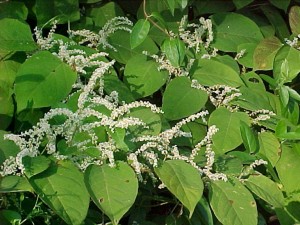An invasion of non-native plant species across Aberdeenshire, and how best to tackle the problem, was the subject of a recent multi-agency workshop. Aberdeenshire Council hosted the workshop for government agencies, river trusts, community councils, landowners and volunteers to look at what work is already being done to control problem plants. Local people are now being urged to help in the fight against invasive non-native species (INNS) which have been introduced deliberately or accidentally to the north-east, well outside their natural geographic range. Plants like Giant Hogweed, Japanese Knotweed and Himalayan Balsam become established in the local environment and can spread rapidly at the expense of native habitat and at substantial financial cost to us all. More than 50 people attended the workshop which provided an opportunity to review efforts to tackle invasive species, much of which is carried out by volunteers. With much more work to be done to tackle the enormous challenge, keeping volunteers motivated is a key challenge and communities across Aberdeenshire are being urged to help stamp out these species before the problem gets any bigger. Chair of the council’s Infrastructure Services Committee, Councillor Peter Argyle, said: “This is a big problem which affects us all and costs us all money. Aberdeenshire Council and other organisations simply cannot deal with this alone. “If you want to be a good citizen and do something that really will make a practical difference – take part in some or all of the five actions listed below. Together we really can help.” Three key INNS are affecting land in Aberdeenshire: Giant hogweed – Can grow to over 3m tall and is seen on many Aberdeenshire river banks. The sap contains a toxic chemical which causes blistering of the skin when it is exposed to sunlight. The hogweed forms dense stands, shading out native plants, blocking riverside footpaths and exposing river banks to erosion when it dies back in the winter. Japanese knotweed – A tall species with bamboo-like stems, which was originally introduced as an ornamental plant. It is now found on river banks, waste ground, roadside verges and some gardens. Able to grow from a tiny fragment of root, the plant spreads easily in soil and extensive roots can penetrate roads, paths and even concrete causing structural damage and shading out native plants. Its destructive nature means its presence close to properties can affect the ability of homeowners to sell or get a mortgage. Himalayan balsam – This plant has attractive pink flowers and is popular with beekeepers, but forms dense stands along river banks where its seeds spread readily. It competes with native plants and can result in erosion of river banks. With INNS already firmly rooted in the Aberdeenshire area, dealing with these species is going to be a long-term task and the recent workshop focused on what needs to be done to take eradication work forward effectively. There is much that local people can do to help tackle this serious problem. Here are a few practical tips which can help: • Learn to recognise these species – good identification guides are available online • Help put together a more accurate picture of where these plants are growing by sending in a record of any you see, in town or the countryside, to the Local Biological Record Centre • Join the conservation volunteers who help organise work groups to control these pests • Join an environmental group working to tackle the issue in your local area, and if there isn’t one, get together with your friends and neighbours to set one up. • Check your own garden or land for invasive species and prevent them spreading.

